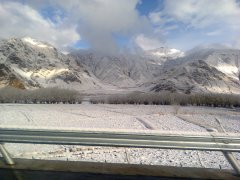
Tips for trekking in Tibet—the roof of the world
trekkers on the way
Thanks to opening of the new Qinghai-Tibet Railway, tourists have convenient access to towering mountains, the world's highest lakes and Tibetan antelopes like never before.
Ready to embark on a trip to Tibet? Here are some warnings and tips to ensure you enjoy the vista of landscapes along the way and avoid the hazards.
What is altitude sickness?
Travellers who ascend rapidly to altitudes greater than 2,500 metres may develop altitude sickness, even if they are in excellent health.
Symptoms of acute mountain sickness, the most common form of the disorder, may include headaches, nausea, vomiting, dizziness, malaise, insomnia, and loss of appetite, according to online medical reference MDtravelhealth.com.
The site warns that severe cases may be complicated by breathlessness, chest tightness, confusion, lethargy and loss of balance, which could be a sign of brain swelling.
For more information on how to battle altitude sickness, visit www.mdtravelhealth.com.
Arm yourself
Bring medicines that are effective for you.
Sunglasses and sunscreen are musts to protect your eyes and skin from the strong sunshine and ultraviolet rays on the plateau.
Wearing a wide-brimmed hat will guard you from the sun. The weather on the plateau changes very fast and unexpectedly, so pack a variety of clothing.
Calm down and relax
Do not engage in strenuous activities, like running or walking too fast in the first few days of reaching the Qinghai-Tibet Pleateau, which is located about 4,000 metres above sea level, where air is extremely thin.
Nervousness may exacerbate your response to the high altitude, so relax. There are oxygen-enriching systems onboard the train to help you breathe more comfortably.
At least one doctor will travel on each passenger train.
There are also well-equipped and staffed hospitals along the way from Xining, Golmud in Qinghai Province, to Lhasa. They are experienced in treating altitude-related diseases.
Mind your food and sleep
Eat low-fat foods and do not have a heavy supper. Alcohol-drinkers should refrain because it could deplete the body of oxygen and even cause bleeding in the digestive tract.
Sleeping with your pillow raised will make breathing easier.
Never hang around alone
Either on the mountainous terrains or in the wilderness, the topology usually looks alike, making it very easy for one to get lost or go astray at stops.
If you feel the urge to wander, go along with other travellers and always take a compass.
Don't touch wild animals
Some animals, like the pika and marmot, may transmit diseases to humans.
Stay away from them.

With exceptional passion and outstanding leadership, Mrs. Catherine has dedicated herself to Tibet inbound tourism and China tour for 15 years. As one of the handful females who see great potential of Chinese inbound tourism, Catherine has made great contribution to promoting Tibet tourism and enhancing the employment of Tibetans and prosperity of local Tibetan community.
Over the years, she travelled overseas with Tibet Tourism Bureau many times to promote Tibet tourism. Currently, Catherine works as the marketing director of Tibet Vista, an opinion leader behind the whole team of Tibet Vista.
Related Articles & Posts

Latest Tibet Travel News

Tibet Vista: A Social Responsible Tour Organizer
Aug 14,2023

Tibetan Monks Debate in Drepung Monastery
Jun 10,2023

Tips for Traveling to Tibet in Spring
Feb 17,2022

Snow Will Hit Qinghai-Tibet Plateau
Feb 17,2022


.jpg)




0 Comment ON "Tips for trekking in Tibet—the roof of the world"